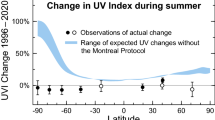Abstract
A method is proposed to provide measurement of direct normal solar irradiance of bands with wavelength ranges (315–400 nm, 400–700 nm) from measurements of global horizontal band irradiance for cloudless sky conditions in Valencia. Global and normal direct irradiance data for every air mass were obtained by applying the SMART2 model to the atmosphere of Valencia. The direct normal to global irradiance ratio was parameterized versus the relative optical air mass. A measurement campaign of global horizontal and diffuse irradiance of UVA and PAR bands was carried out in Valencia, after which, the inferred direct normal irradiance was compared with those provided by the method. The result of the comparison shows that the method is acceptably accurate. The proposed model tends to underestimate the direct normal irradiance of the UVA band by 6%, although for values below 25 W/m2 the model overestimates the direct irradiance by 6%, while for values above 25 W/m2 the model underestimates it by 10%. The other two error estimators used ranging from 11% to 15% are similar in the defined interval measurements in relation to the whole UVA band. Regarding the PAR band, the model overestimates the direct normal irradiance of the PAR band by only 2.2%. With this, the results of the PAR band are more conclusive, as it has been found that for direct normal irradiance values higher than 280 W/m2 the MBE error is almost zero and the other two estimator errors are small, about 5%.




Similar content being viewed by others
References
Barth J, Cadet J, Césarini JP, Fitzpatrick TB, McKinlay A, Mutzhas M, Pathak M, Peak M, Sliney D, Urbach F (1999) TC 6-26 report: Standardization of the terms UV-A1, UV-A2 and UV-B, CIE 134-1999 ISBN 3-900-734-94-1
Batlles FJ, Olmo FJ, Alados-Arboledas L (1995) On shadowband correction methods for diffuse irradiance measurements. Solar Energy 54(5):105–114
Drummond AJ (1956) On the measurement of sky radiation. Arch 602 Meteor Geophys Bioklim B 7:413–436
Gueymard C (1995) SMARTS2: a simple model of the atmospheric radiative transfer of sunshine: algorithms and performance assessment. FSEC-PF-270-95, Florida Solar Energy Center
Gueymard C (2003) SMARTS2 code, versión 2.9.2. User’s Manual, Solar Consulting Services Bailey CO. Available from http://rredc.nrel.gov/solar/models/SMARTS/smarts_index.html
Gueymard C (2004) The sun’s total and spectral irradiance for solar energy applications and solar radiation models. Solar Energy 76:423–453
Häder DP, Lebert M, Marangoni R, Colombetti G (1999) ELDONET-European light dosimeter network hardware and software. J Photochem Photobiol B: Biol 52:51–58
Häder DP, Lebert M, Colombetti G, Figueroa F (2001) European light dosimeter network (ELDONET). Helgol Mar Res 55:35–44
Iqbal M (1983) An introduction to solar radiation. Academic, Toronto
Kudish AI, Evseev EG (2008) The assessment of four different correction models applied to the diffuse radiation measured with a shadow ring using global and normal beam radiation measurements for Beer Sheva, Israel. Solar Energy 82(2):144–156
LeBaron BA, Michalsky JJ, Perez R (1990) A simple procedure for correcting shadowband data for all sky conditions. Solar Energy 44:249–256
Marín Fernández MJ (2007) Estudio de la irradiancia solar ultravioleta y eritemática en la Comunidad Valenciana. Doctoral Thesis University of Valencia (Spain)
Perez R, Ineichen P, Seals R, Michalsky JJ, Stewart R (1990) Modelling daylight availability and irradiance components from direct and global irradiance. Sol Energy 44:271–289
Pinazo JM, Cañada J, Bosca JV (1995) A new method to determine Ångström's turbidity coefficient: its application for Valencia. Solar Energy 54:219–226
Serrano MA, Boscá JV, Cañada J (2008) The determination of a band factor to express irradiance of UV and PAR wavelength ranges in a clean and dry atmosphere at Valencia (Spain). Int J Ambient Energy 29(4):171–180
Utrillas MP, Boscà JV, Martinez-Lozano JA, Cañada J, Tena F, Pinazo JM (1998) A comparative study of Spectral2, and Smarts2 parameterised models based on spectral irradiance measurements at Valencia, Spain. Solar Energy 63:161–171
Utrillas MP, Marín MJ, Esteve AR, Tena F, Cañada J, Estellés V, Martínez Lozano JA (2007) Diffuse UV erythemal radiation experimental values. J Geophy Res 112:387–395
Acknowledgments
This work was supported by the Spanish Government through MEC grant MAT2009-14625-C03-03, and is a part of the activities of the Grup d'Optoelectrónica i Semiconductors of the Polytechnic University of Valencia. The translation of this paper was funded by the Universidad Politécnica de Valencia, Spain.
Author information
Authors and Affiliations
Corresponding author
Rights and permissions
About this article
Cite this article
Serrano, MA., Boscà, J.V. Validation of a method to estimate direct normal irradiance of UVA and PAR bands from global horizontal measurements for cloudless sky conditions in Valencia, Spain, by a measurement campaign. Theor Appl Climatol 103, 95–101 (2011). https://doi.org/10.1007/s00704-010-0284-9
Received:
Accepted:
Published:
Issue Date:
DOI: https://doi.org/10.1007/s00704-010-0284-9




